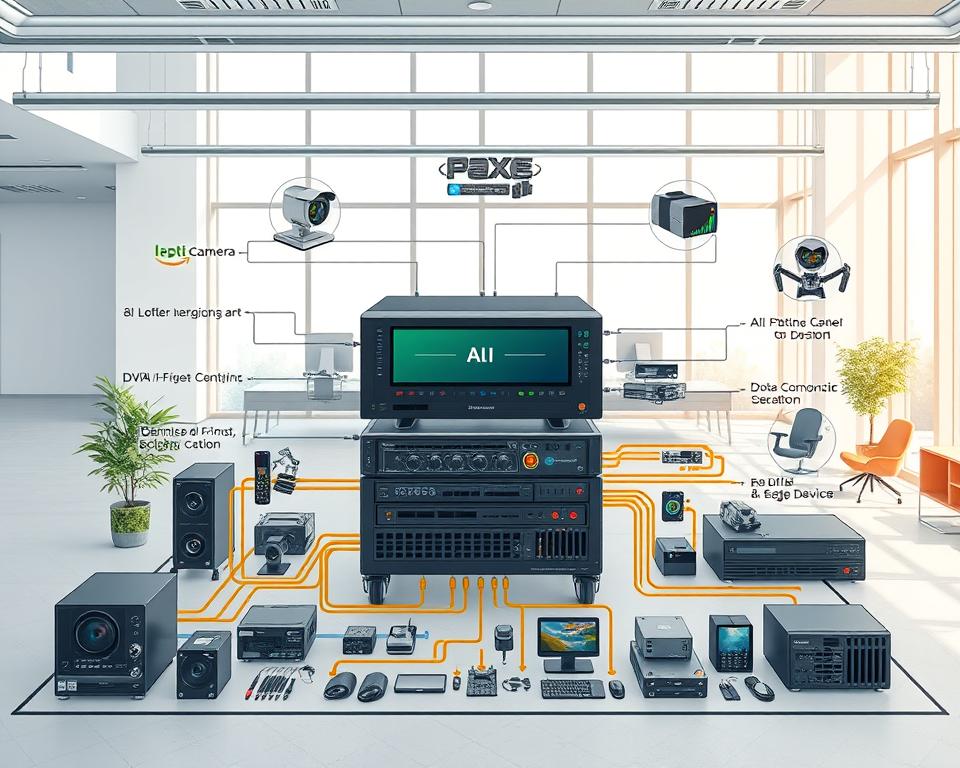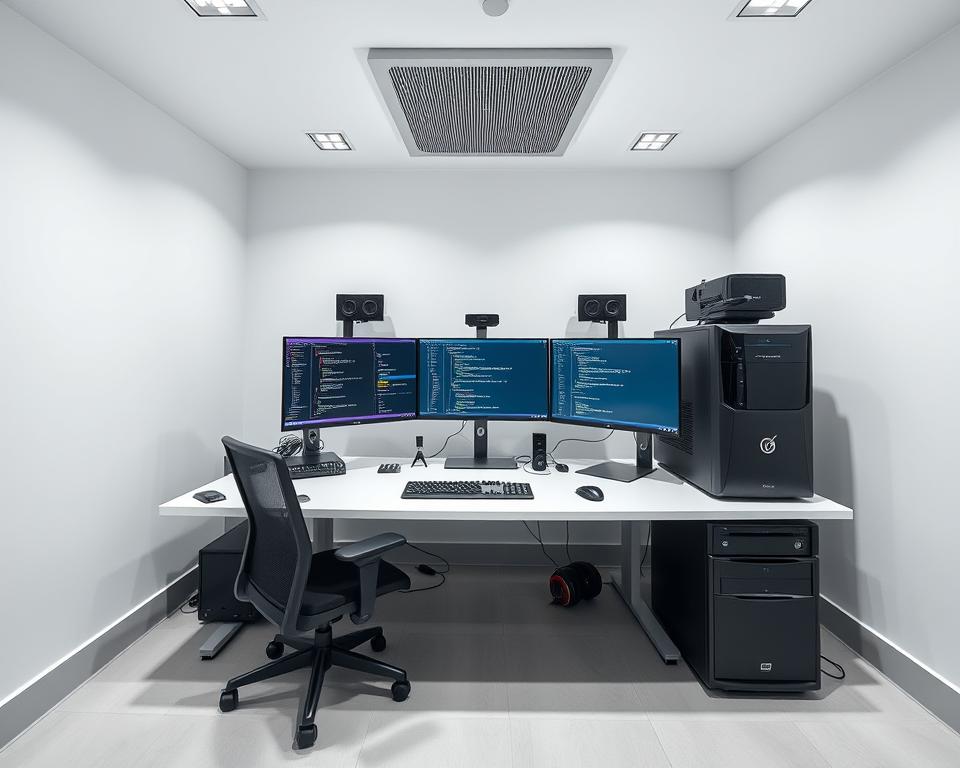Artificial intelligence is changing how we use technology. Image recognition is a big part of this change. Computers can now understand visual information, thanks to machine learning. This lets us have self-driving cars and facial recognition systems.
To learn more about making an AI-based app, check out image recognition technology. It opens up a world of possibilities.
Image recognition technology has many uses. It’s used in security, healthcare, and entertainment. Developers use artificial intelligence and machine learning to make tools that can spot objects, people, and patterns. This tech is growing fast and has huge potential.
Table of Contents
Key Takeaways
- Artificial intelligence and machine learning are key components of image recognition technology.
- Image recognition has numerous applications, including security, healthcare, and entertainment.
- Developers can create powerful visual identification tools using artificial intelligence and machine learning.
- Image recognition technology is rapidly evolving and has vast potential.
- Machine learning algorithms play a crucial role inichertaining the accuracy of image recognition systems.
- Artificial intelligence-powered image recognition systems can be used in various industries, including retail and finance.
Understanding Image Recognition Technology
Image recognition technology is key in artificial intelligence. It lets computers understand visual information. This field, called computer vision, helps computers see like humans do. With AI-powered image recognition, computers can spot patterns, objects, and features very well.
The uses of image recognition are wide and varied. It’s used in security, healthcare, and even on social media. Here are some examples:
- Security surveillance: It helps spot people and odd activities, making places safer.
- Healthcare diagnostics: It aids doctors in diagnosing diseases faster and more accurately, helping patients.
- Social media photo tagging: It automatically tags people in photos, making sharing easier.
Exploring image recognition technology is important. We’ll look into computer vision and AI-powered image recognition more. We’ll also see how it’s used in different areas.
Essential Prerequisites for Development
To make an AI-based image recognition app, you need some key things. First, you must understand AI and machine learning well. You also need to know how to program in languages like Python or Java. Plus, knowing about image recognition and deep learning is crucial.
Having the right skills and knowledge is vital. Some important skills include:
- Programming skills in languages such as Python or Java
- Knowledge of image recognition techniques and deep learning frameworks
- Experience with data preprocessing and model training
It’s also important to keep up with new tech and techniques. You can do this by going to conferences, reading research papers, and joining online forums. With the right development prerequisites, your app will work well and be accurate.
With the right AI development skills and image recognition knowledge, you can make amazing AI apps. These apps can help many industries and meet different needs.
Choosing Your Tech Stack
Building an AI-based image recognition app requires the right tech stack for AI. You need to pick the best programming languages, like Python or R. These languages are key in AI development and affect the app’s performance and upkeep.
The tech stack for AI also includes choosing a framework, like TensorFlow or PyTorch. These frameworks offer tools for building and training AI models. Also, using cloud services for image recognition, like Google Cloud Vision or Amazon Rekognition, can speed up development. These services have features like image classification and facial recognition.
Key Considerations for Tech Stack Selection
- Programming languages for AI, such as Python or R
- Framework selection, including TensorFlow or PyTorch
- Cloud services for image recognition, such as Google Cloud Vision or Amazon Rekognition
Choosing the right tech stack for AI is crucial. It helps developers create efficient and accurate image recognition apps. The selection of programming languages for AI and cloud services for image recognition greatly impacts the app’s success.
Setting Up Your Development Environment
To begin building an AI-based image recognition app, you must set up a proper development environment. You’ll need to install AI tools and libraries like TensorFlow or OpenCV. Also, make sure your environment can handle image recognition tasks. A good setup is key for smooth app development and testing.
Choosing the right image recognition libraries is essential. These libraries offer pre-made functions for image work, simplifying your app’s development. OpenCV and Pillow are among the most popular. Make sure your AI development tools, like TensorFlow or PyTorch, work well with these libraries.
Here’s how to set up your development environment effectively:
- Install the necessary AI development tools and libraries
- Configure the environment to support image recognition tasks
- Ensure compatibility between tools and libraries
- Test the environment to ensure it is working correctly
By following these steps and using the right tools and libraries, you can create a great development environment. This lets you focus on making a top-notch image recognition app. You won’t waste time on setting up the environment.
| Library | Description |
|---|---|
| OpenCV | A computer vision library with image and video processing functions |
| Pillow | A library for image processing and analysis |
| TensorFlow | A machine learning library with tools for AI development |
How to Build an AI-Based Image Recognition App: Step-by-Step Guide
To create an AI-based image recognition app, follow a detailed guide. This ensures all parts are set up and work together well. It starts with organizing the project structure and setting up your development environment.
A good project structure is key for the app’s success. It helps developers manage and keep the code in order. The app’s core functions, like loading images, preparing them, and extracting features, are also very important.
Project Structure Setup
Setting up the project structure means creating a clear folder and file hierarchy. You’ll need separate areas for the app’s front-end and back-end code. Also, folders for image data and models are necessary.
Installing Dependencies
After setting up the structure, install the needed libraries and frameworks. These might include tools for image processing, machine learning, and storing data.
Building the Core Functions
The app’s core functions are vital. They let the app load, prepare, and analyze images. This way, it can make predictions or classifications based on the image data.
Implementing the Image Processing Pipeline
The image processing pipeline is key in AI-based image recognition apps. It includes image preprocessing to improve images, feature extraction to find important details, and classification algorithms to guess what’s in the images.
Image preprocessing might involve resizing or cropping images. These steps make images better for feature extraction. Then, feature extraction methods like CNNs pull out important details. These details are used by classification algorithms, like SVMs, to guess what’s in the images.
To learn more about making image recognition apps better, check out optimizing performance tips for web and mobile apps. Improving the image processing pipeline can make apps more accurate and fast. Developers can use parallel processing and distributed computing to boost performance.
The table below shows the main steps in the image processing pipeline:
| Step | Description |
|---|---|
| Image Preprocessing | Techniques to enhance or normalize the images |
| Feature Extraction | Methods to extract relevant features from the images |
| Classification | Algorithms to predict the labels or categories of the images |
By following these steps and improving the image processing pipeline, developers can make image recognition apps that work well and fast.
Training Your Image Recognition Model
Training an image recognition model is a key step. It involves picking and preparing the dataset, selecting the right machine learning algorithms, and optimizing the model. The aim is to get high accuracy and efficiency in recognizing images. Developers use machine learning algorithms to learn from data and get better over time.
Model optimization is crucial in this process. It means tweaking the model’s settings to lower the error rate and boost performance. Hyperparameter tuning and regularization are effective ways to do this. They help avoid overfitting and enhance the model’s ability to generalize.
When training an image recognition model, consider these key points:
- Choosing the right machine learning algorithms for the task
- Preparing a high-quality dataset that mirrors the problem domain
- Optimizing the model’s performance with model optimization techniques
- Checking the model’s performance with evaluation metrics like accuracy and precision
Here’s a simple table highlighting the importance of training image recognition model:
| Model Type | Training Time | Accuracy |
|---|---|---|
| Basic Model | 1 hour | 80% |
| Optimized Model | 5 hours | 95% |
By sticking to best practices and using the right machine learning algorithms and model optimization methods, developers can build accurate and efficient image recognition models. These models can be used in many applications.
Creating the User Interface
Building an AI-based image recognition app needs a great user interface. It should be easy to use and give feedback quickly. This is done by using frontend development and thinking about the layout, typography, and colors.
A good interface meets the user’s needs and goals. It should guide users through the image recognition process clearly. Also, it should work well on different screens and devices, so users have a consistent experience.
Some important things to think about when designing the interface include:
- Using a consistent design language throughout the app
- Providing clear and concise feedback to the user
- Ensuring accessibility for users with disabilities
- Conducting user testing and gathering feedback to iterate and improve the design
By focusing on user experience and using frontend development best practices, developers can make an interface that is both intuitive and engaging. This can make users happier, increase app use, and give you a competitive edge.
| Design Principle | Description |
|---|---|
| Clarity | Presenting information in a clear and concise manner |
| Consistency | Using a consistent design language throughout the app |
| Feedback | Providing timely and relevant feedback to the user |
Testing and Quality Assurance
It’s key to make sure the AI-based image recognition app works right. That’s why testing and quality assurance are so important. They check if the app does what it’s supposed to do well.
Developers use unit testing to check each part of the app. They also do performance testing to see how fast and efficient it is. And they make sure it’s easy for users to use with user acceptance testing.
- Unit testing: Verifies individual components to ensure they function as expected.
- Performance testing: Evaluates the app’s speed and efficiency to ensure it meets the required standards.
- User acceptance testing: Validates the app’s functionality and usability to ensure it meets the user’s needs.
By using these tests, developers can make sure the app works well. This gives users a smooth experience.
| Testing Method | Purpose |
|---|---|
| Unit Testing | Verifies individual components |
| Performance Testing | Evaluates app’s speed and efficiency |
| User Acceptance Testing | Validates app’s functionality and usability |
Deploying Your Application
After you’ve built and tested your AI-based image recognition app, it’s time to share it with others. This is when app deployment is crucial. You can deploy your app through cloud deployment services like AWS or Google Cloud. Or, you can choose mobile app deployment on app stores like Apple App Store or Google Play.
The deployment process should make your app easy to use, secure, and accessible. Here are some important things to consider for a successful deployment:
- Choose a reliable cloud services provider to host your app
- Optimize your app for mobile devices to ensure seamless user experience
- Implement robust security measures to protect user data
By following these best practices, you can ensure a smooth and successful deployment of your AI-based image recognition app. Whether you choose cloud deployment or mobile app deployment, the key is to make your app easy to use and accessible.
With the right deployment strategy, you can boost user engagement and grow your business. Think about your target audience and pick the best deployment method for them. This way, your app can reach its full potential and offer a great user experience.
Optimization and Performance Tuning
To make sure the AI-based image recognition app works well, we need to focus on optimization and performance tuning. This means managing memory to avoid leaks and use it wisely. It’s key to keeping the app running smoothly.
Developers can boost the app’s efficiency by using smart performance tuning methods. This makes the app faster and more reliable.
Some important steps for optimization include:
- Using parallel processing to speed up processing speed
- Adding GPU acceleration for better computing power
- Optimizing code to use less memory and improve memory management
By using these methods, developers can make sure their app grows with demand. This is crucial for apps that need to handle lots of data quickly and efficiently. Good optimization and performance tuning lead to a better user experience and app performance.
It’s also important to think about scalability. This ensures the app can handle more users or data. By doing this, developers can build a top-notch AI-based image recognition app that meets user needs.
| Optimization Techniques | Benefits |
|---|---|
| Parallel Processing | Enhanced processing speed |
| GPU Acceleration | Improved computational power |
| Code Optimization | Improved memory management |
Security Best Practices
Protecting an AI-based image recognition app and its users is key. This means keeping data safe with encryption and secure storage. It also involves setting up access control like authentication and authorization. Plus, keeping the app updated to avoid security holes.
Developers can follow some important steps. These include:
- Encrypting sensitive data both in transit and at rest
- Implementing secure authentication and authorization protocols
- Regularly updating and patching the app to prevent vulnerabilities
- Conducting regular security audits and penetration testing
By sticking to these security best practices, developers can keep user data safe and secure. This is especially true for apps that deal with sensitive information.
Also, using access control can stop unauthorized access. This can include things like multi-factor authentication and secure password storage.
Putting a focus on data protection and security best practices builds trust with users. It’s crucial for the app’s success. Developers need to stay proactive with updates, patches, and security checks to protect against threats.
Conclusion
Building an AI-based image recognition app is a complex task. It needs careful planning and execution. The future of image recognition is bright, with many uses across industries. Developers and entrepreneurs must keep up with new AI advancements and best practices.
This article’s end marks the start of a new era in image recognition tech. AI’s progress will bring big changes to image recognition. Understanding image recognition tech and using the latest advancements is key. This way, we can fully use image recognition and look forward to a better future.



















